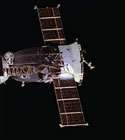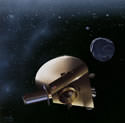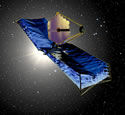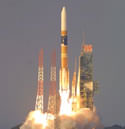
Image credit: NASA
After four days in space, a Russian Progress M1-9 docked with the International Space Station on Sunday afternoon at 1701 GMT (1:01pm EDT). The unmanned cargo vessel carries 2.6 tons of food, fuel and equipment for the station. The operation took a little longer than normal because Russian controllers used the opportunity to test the Kurs automated docking system employed on the Zvezda module.
An unmanned Russian resupply craft successfully docked to the International Space Station Sunday, bringing almost a ton of food, fuel and supplies to the residents on board, and for the next trio of space travelers, which will arrive on the ISS in November.
The Progress 9 vehicle linked up to the aft docking port of the Zvezda Service Module of the ISS at 12:01 p.m. Central time (1701 GMT) as the two spacecraft flew over Central Asia after a four-day flight following its launch Wednesday from the Baikonur Cosmodrome in Kazakhstan. The automated docking went off without a hitch as Expedition 5 Commander Valery Korzun, NASA ISS Science Officer Peggy Whitson, and Flight Engineer Sergei Treschev viewed the arrival of the new capsule from inside Zvezda. A few minutes later, hooks and latches closed between the two vehicles to form an airtight seal.
Korzun was prepared to take over manual control of the Progress for the docking in the event its automated rendezvous system did not work, but the linkup was executed flawlessly.
The crew was scheduled to open hatches between Zvezda and Progress this afternoon and will begin unloading supplies from the craft on Monday.
Some of the supplies include clothing and personal items for the Expedition Six crew ? Commander Ken Bowersox and Flight Engineers Nikolai Budarin and Don Pettit ? who will be launched aboard Endeavour on the STS-113 mission in November to replace Korzun, Whitson and Treschev following the completion of their 5 ? month mission.
The older Progress 8 vehicle, which arrived at the ISS in June and which was undocked on Tuesday, remains in orbit a safe distance away from the station, spending another 10 days aloft to enable Russian flight controllers to document smog and smoke over northeastern Russia through its cameras.
The Progress docking clears the way for the launch of Atlantis on the STS-112 mission Wednesday to deliver the 14-ton Starboard 1 (S1) Truss to the station. A Wednesday launch would result in Atlantis? docking to the ISS Friday. Commander Jeff Ashby, Pilot Pam Melroy and Mission Specialists Dave Wolf, Sandy Magnus, Piers Sellers and Fyodor Yurchikhin are in the final stages of their prelaunch preparations.
Original Source: NASA News Release



